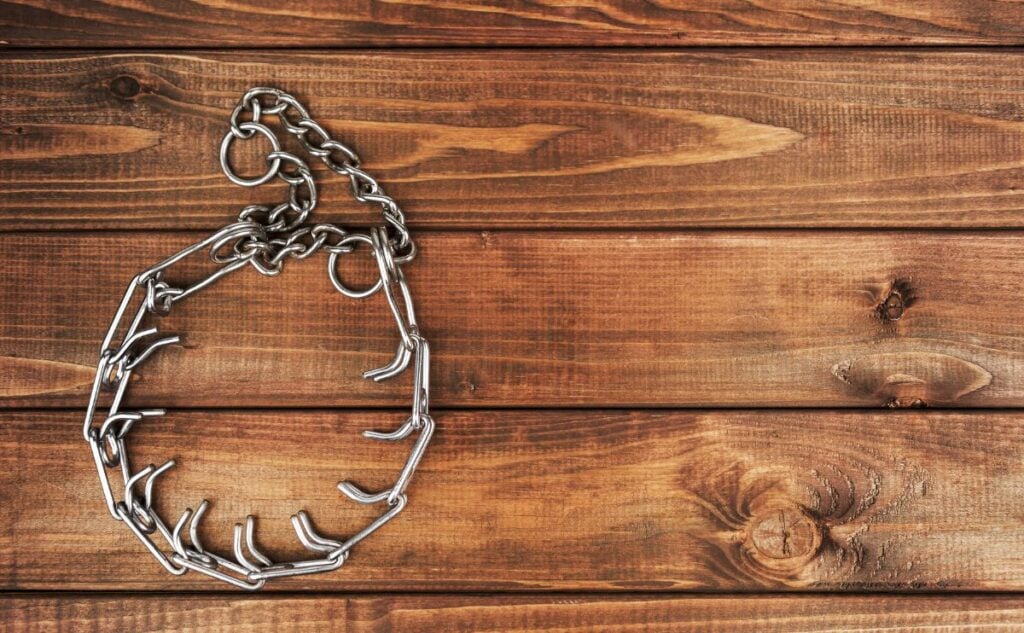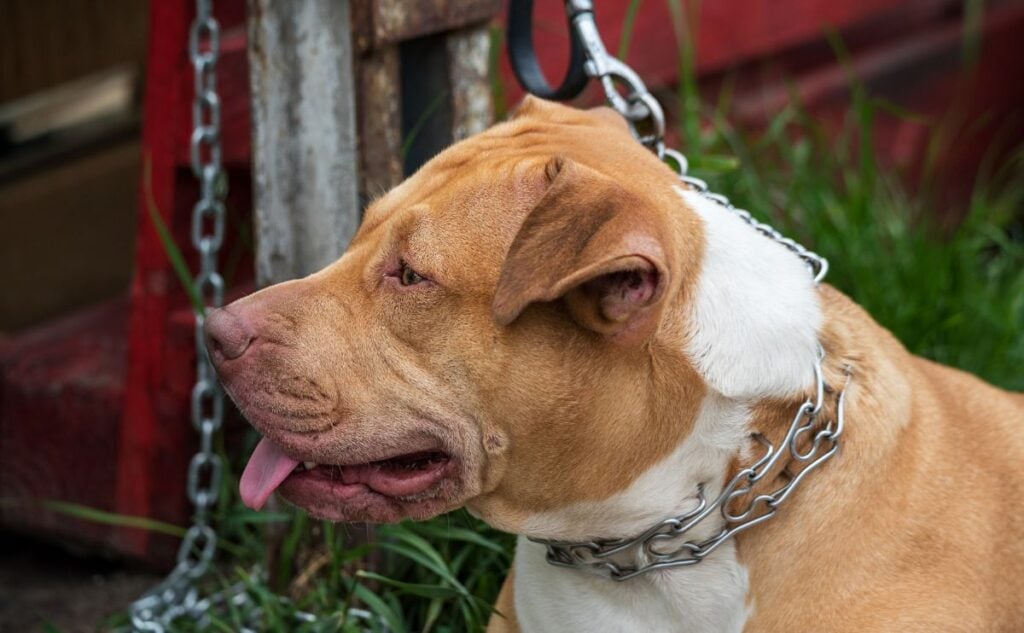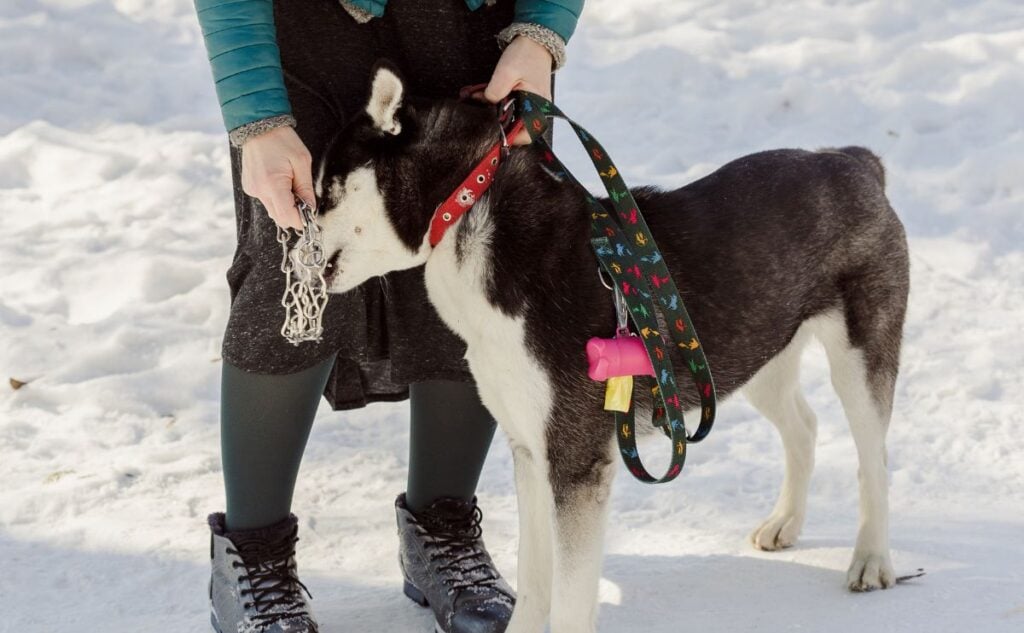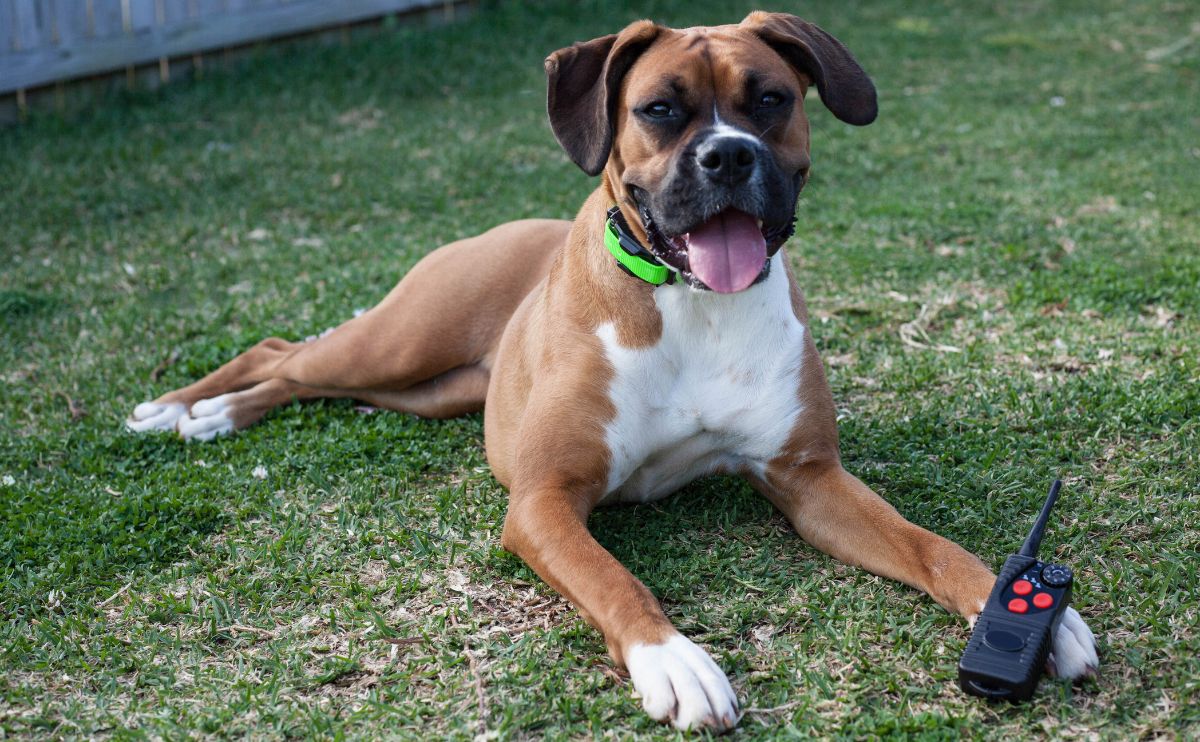Dog Trainers Are At War Over Pinch Collars—Where Do You Stand?
When you purchase through links on our site, we may earn a commission. Here’s how it works.
Few dog training tools spark as much outrage, debate, and division as the pinch collar. Some trainers swear by them, calling them a lifesaver for controlling powerful, unruly dogs. Others argue they’re unnecessary, outdated, or even cruel. Scroll through any dog training forum, and you’ll see heated arguments, strong opinions, and no shortage of finger-pointing.
Table of Contents

So, where do you stand? Are pinch collars an effective training tool or a shortcut with painful consequences? This article cuts through the noise, breaks down the real pros and cons, and—most importantly—explains how to use a pinch collar safely and responsibly if you choose to do so.
What Is A Pinch Collar?
A pinch collar is a metal training collar with interlocking links with prongs that rest against a dog’s skin. Unlike traditional collars, a pinch collar tightens slightly when a dog pulls, applying pressure to the neck to discourage unwanted behavior.
It’s one of the most controversial training tools because improper use can cause discomfort or harm. However, when used correctly, many trainers and dog owners report success with large, strong-willed dogs.
A pinch collar is most commonly used for:
- Teaching a dog to heel and walk politely on a leash
- Discouraging pulling during walks
- Helping with impulse control, such as ignoring distractions
- Managing leash-reactive or dog-aggressive behavior in public spaces
Pinch collars are best suited for large, strong dogs with thick or muscular necks. They are not recommended for small or fragile breeds due to the potential for injury.
Pinch Collar vs Prong Collar
While some may think pinch and prong collars are different, they refer to the same type of collar. The term pinch refers to how you have to pinch the prongs to open and close the collar, while prong relates to the prongs that protrude toward the neck and are the mechanism for training.
How Does A Pinch Collar Work?
A pinch collar applies gentle pressure around the neck when the dog pulls on the leash, mimicking the natural correction a dog might receive from another dog or its mother.

Proper fit is key: The collar should sit high on the neck, just behind the ears, and be snug but not tight. If it’s too loose, it won’t work correctly. If it’s too tight, it could cause discomfort or injury.
As your dog pulls, the collar tightens slightly, applying even pressure across the neck. When your dog stops pulling, the pressure is released immediately.
Are Pinch Collars Safe?
While not everyone agrees, a pinch collar can be safe and effective when appropriately used. The risks come when owners misuse them.
Much of the criticism is associated with individuals who misuse the collar and snap on the leash to suddenly tighten the collar and, therefore, cause increased pain and potential tissue damage to the dog.
There’s also the potential of choking the dog if the collar doesn’t fit correctly. A vet or pet store specialist should fit your pinch collar if you’re unsure how to fit it correctly. When used correctly, the collar is a preventative measure to help your dog remember his manners in public.
If you use a pinch collar, work with a qualified trainer to ensure it’s fitted and used correctly.
Why Are Pinch Collars So Controversial?
Few dog training tools ignite as much passion and division as the pinch collar. Depending on who you ask, it’s either an indispensable training tool or a harmful, outdated method that does more harm than good.

The Case For Pinch Collars
- They mimic natural corrections: Some trainers argue that pinch collars replicate how a mother dog corrects her puppies—with quick, precise pressure rather than constant discomfort.
- They provide immediate feedback: A light tug signals the dog to adjust its behavior, making it a clear and effective communication tool.
- They help strong, stubborn dogs: A pinch collar can provide extra control to ensure safety for powerful or headstrong breeds.
- They reduce pulling without constant pressure: Unlike a flat collar, which can choke a pulling dog, a pinch collar applies pressure only when necessary and releases instantly.
The Case Against Pinch Collars
- They can cause pain or fear (if misused): If fitted incorrectly, used with excessive force, or left on too long, pinch collars can cause pain, stress, or injury to a dog’s neck.
- They can be a shortcut for poor training: Some argue that pinch collars don’t teach proper leash manners—they suppress behavior through discomfort rather than helping the dog learn through positive reinforcement.
- They may lead to fear-based behavior: Some studies suggest that aversive training tools (pinch collars and shock collars) can increase a dog’s anxiety or reactivity, especially in nervous dogs.
- Beginners easily misuse them: A common mistake is yanking too hard, leaving the collar on for hours, or using it on a dog that doesn’t need it. Without proper training, some owners unknowingly hurt their dogs rather than helping them.
How To Use A Pinch Collar
Using a pinch collar correctly is crucial to ensuring your dog’s safety and effectiveness in training. Follow these steps:
- Proper fit: The pinch collar should sit high on the neck, just behind the ears, and fit snugly without being too tight. You should be able to fit two fingers between the prongs and your dog’s neck.
- Correct placement: Do not place the collar too low on the neck, as this can lead to ineffective corrections and potential injury.
- Attaching the leash: Connect the leash to the live ring for training. If you want a milder correction, attach it to the dead ring, which reduces the tightening effect.
- Applying gentle corrections: When your dog pulls or misbehaves, apply a quick, light tug on the leash to communicate that the behavior is unwanted. Avoid sustained pressure or harsh yanking.
- Positive reinforcement: Always pair corrections with praise or treats when your dog responds correctly. This prevents fear and helps reinforce good behavior.
- Use only during training sessions: Never leave a pinch collar on your dog unsupervised. It should be used only during training walks or structured sessions.
- Regularly check for proper fit: Dogs grow and change weight, so periodically inspect the collar for proper fit and ensure it’s in good condition.
Common Mistakes To Avoid
Even well-intentioned dog owners can misuse a pinch collar, leading to discomfort or ineffective training. Here are the most common mistakes:
- Using the wrong size collar: A loose collar won’t work correctly, while an overly tight one can cause pain.
- Placing it too low on the neck: It should sit high on the neck, near the ears.
- Leaving it on all the time: Pinch collars should only be used during training sessions.
- Yanking too hard: A pinch collar is meant for gentle corrections, not punishment.
- Not combining it with positive reinforcement: Pinch collars should be used alongside rewards and encouragement.
Just Say No To Pinch Collars For Small Dogs
While there are varying opinions, we feel that a pinch collar on a small dog is not a good idea. Since a pinch collar should fit close to a dog’s skin but should never be too tight or too small for the dog in question, we advise against using a pinch collar on toy dog breeds with more fragile bodies. The collar can apply significant force to a small dog’s neck.

There’s a microprong collar designed to keep the trachea from collapsing—the primary concern for tiny dogs. When fitted correctly, this product claims to be safe for little dogs.
Alternative Training Methods
Pinch collars aren’t the only training option. Here are some practical alternatives for leash training:
- Martingale collars: A gentler option for dogs that slip out of regular collars.
- Head halters (e.g., Gentle Leader, Halti): Designed to prevent pulling without pressure on the neck.
- Front-clip harnesses: Helps reduce pulling by redirecting the dog’s movement.
- Positive reinforcement training: Using treats, praise, and clickers to encourage good behavior.
Personal Experience: Training A Dog With A Pinch Collar
One of our writers, Kimberly Alt, took her dog, Sally, to a professional trainer who recommended a pinch collar. Here’s her firsthand experience:
When the trainer put the pinch collar on Sally, my heart sank. It looked like a torture device. But as she explained how to use it correctly, I realized it wasn’t about pain—it was about communication.
My trainer explained to me thoroughly how to properly use a pinch collar on Sally. She stressed that I should never have continuous pressure on the collar, i.e., the leash should never be tight and should always have slack.
The trainer passed the leash to me, and as I worked on commands with Sally, I noticed how much more responsive Sally was. I know when my dog is in pain, and the soft tugs I was giving Sally to help direct her were not causing any pain at all.
My dog trainer also mentioned that the best way to use it is to give soft tugs when your dog is doing something wrong. So, if Sally is walking too far ahead, I can give a soft tug to help her fall back in line with me.
Another thing Sally struggled with was being protective of me on our walks (she still struggles with this some). She would bark and lunge at other dogs in a protective manner. Using the pinch collar to correct this has been extremely beneficial because we look for early warning signs and give soft corrections to the leash to direct her attention elsewhere.
– Kimberly Alt, Dog Mom & Pet Insurance Expert For Canine Journal

Frequently Asked Questions
Here are some frequently asked questions we think our readers will want to learn more about. Don’t see yours? Ask us in the comments!
Are Pinch Collars Illegal?
The legality of pinch collars varies depending on where you live. Some countries and cities have outright bans on their use, considering them inhumane training tools, while others allow them as long as they are used responsibly. If you are unsure about your local regulations, check with your city’s animal control department or a professional dog trainer to ensure you comply with the law.
At What Age Can A Dog Start Using A Pinch Collar?
Most trainers recommend waiting until a dog is 5-6 months old before introducing a pinch collar. Puppies younger than this are still developing physically and mentally, and using a pinch collar too early could cause unnecessary stress or harm. If your puppy struggles with leash training, start with a standard collar, harness, or positive reinforcement techniques before considering a pinch collar under professional guidance.
Can A Pinch Collar Be Used For Off-Leash Training?
No, a pinch collar is designed to work only when attached to a leash. The correction mechanism relies on slight leash pressure, which means it is ineffective for off-leash training. If you want to work on off-leash obedience, consider using a long training lead, positive reinforcement, or remote collars under the supervision of an experienced trainer.
What Is The Best Prong Collar?
Our pick for the best prong collar is the Herm Sprenger Prong Dog Training Collar. This collar is a typical recommendation from trainers who use this type of training and is available in a few sizes. In addition to the classic chrome collar, you can also get this collar in black.
More Than One Way To Collar Train
Pinch collars aren’t the only way to collar train your pup. There are a variety of dog training collars that might suit your needs. From helping to reduce barking to obedience training, you’ll find a collar that might be helpful.
Why Trust Canine Journal?
Michelle has been a dog owner her entire life and is currently a co-parent to two rescue pups, Barley and Lily. Michelle specializes in pet insurance for dogs. She’s part of a team of dog specialists at Canine Journal who have over a decade of experience researching, testing, and writing about everything you need to know to keep your pup healthy and happy.



